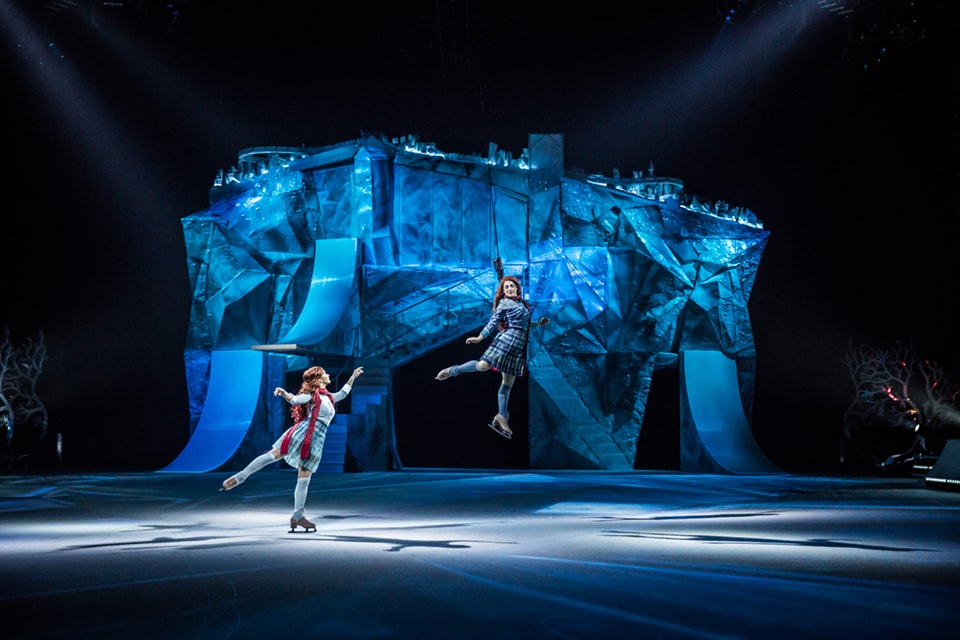Cirque du Soleil’s Crystal is staged on a slick sheet of ice where acrobats and skaters combine to create an amazing entertainment. A spectacular array of chills and charms to thrill and warm the heart, it’s perfect family-friendly fare for this time of year. Plus it’s got the girl-power appeal of Mean Girls meets Frozen meets Wonder Woman.
The storyline that threads through this intersection of ice and circus centers on a young girl named Crystal. Her dull suburban family and superficial peers think she’s weird and strange. She feels a misfit and all alone. So she skates away from home and finds herself on a frozen pond. But she’s on thin ice and it cracks and she tumbles down below. There she meets a reflection of herself, like a supportive doppelganger, who gives her a pen, and she begins to find her voice through writing (“I can make a map of my mind with a stroke of my pen!” she says in voiceover). Crystal now imagines a series of retro and futuristic worlds that seem surreal but actually arise from her memories of real-life—places like a playground, a school room, an office, a prom—and each such situation becomes the site of another stupendous circus act or dance or skating stunt. Finally, having realized and mastered her creative powers, Crystal is able to return to reality and to her family as her true self (“I know who I am!”).

As with nearly all Cirque productions, there’s preshow clowning and fun with the audience—in this case involving a lot of snowball throwing. The cool blue-white unit set is an ice palace with rooms inside and skating ramps outside. Stainless steel trees, sounds of winter wind, and a trash barrel fire set the scene.
Crystal was designed to be performed in stadiums, and its ice-rink playing area is more vast than what would fit inside a traveling tent. Cirque regulars may note that the arena space seems less intimate, and audience responses less unison, than in the wrap-around enclosure of a typical Cirque big top. But the acoustics and sightlines are just fine. And the upside tradeoff is the animated projections that flood the flat white ice surface with stunning visions of color and motion.
Cirque often launches new productions not only with fresh themes and design schemes but also with technical breakthroughs behind the scenes. In the case of Crystal, that meant fabricating synthetic ice to cover sloping ramps so that the extreme skaters in the cast can do their insane derring-do like skateboarders do. It also meant devising a mind-blowing visual illusion: At times there appear gorgeous whorls and trails on the ice, as if in the wake of performers’ skates. It’s not CGI’ed beforehand. It’s responsive video that follows the flow of motion of the skaters in real time then instantly projects patterns based on it onto the ice. Thus the fantastic skating creates fleeting works of art before our eyes. And it’s as hypnotically wonderful to behold as anything I’ve seen in Cirque.

Musically Crystal is a departure for Cirque. There are a few onstage musicians—accordion, violin, clarinet, guitar. But mainly we hear lush recordings that include both original compositions and covers of such popular songs as sia’s Chandelier and Beyonce’s Halo. This works great because it keeps the show’s point of view the mind of a relatable young girl of today. Costuming and makeup choices are similarly kept contemporary. The circus acts are also more human scale: Cirque’s trademark phantasmagorica and esoterica have been left out so that we can perceive the performances Crystal imagines as not far removed from her actual life.
What stands out in Crystal—besides the crazy talent of the skaters and acrobats in the company—is the emotional storytelling of its choreography. For instance there comes a point when Crystal wonders aloud whether she will ever meet another heart with whom she might share her own. Enter from overhead a young man suspended from red straps. To say he’s a Prince Charming figure does not do justice to the moving romanticism with which he and Crystal connect as coequals and commune in midair.

Crystal, who is onstage for most of the show’s two hours, is played by Nobahar Dadui with awesome grace, strength, and stamina. It is a star-quality performance—and the best solo work I can recall seeing in my decades of appreciating Cirque.
Whether you’re a fan of Cirque or a first-timer, you’ll find in Crystal a gem of a show. But you have to act fast: It’s in town in DC for only the weekend.
Running Time: Approximately two hours, plus a 20-minute intermission.
Crystal plays through December 9, 2018, at Cirque du Soleil performing at Capital One Arena, 601 F Street NW, Washington, DC. Tickets are available online.




